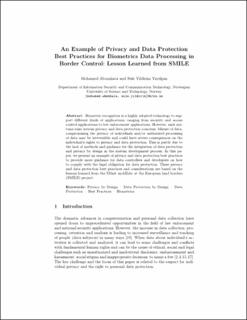| dc.contributor.author | Abomhara, Mohamed Ali Saleh | |
| dc.contributor.author | Yildirim Yayilgan, Sule | |
| dc.date.accessioned | 2021-09-23T06:16:14Z | |
| dc.date.available | 2021-09-23T06:16:14Z | |
| dc.date.created | 2021-02-09T10:21:04Z | |
| dc.date.issued | 2021 | |
| dc.identifier.issn | 1865-0929 | |
| dc.identifier.uri | https://hdl.handle.net/11250/2780596 | |
| dc.description.abstract | Biometric recognition is a highly adopted technology to support different kinds of applications, ranging from security and access control applications to low enforcement applications. However, such systems raise serious privacy and data protection concerns. Misuse of data, compromising the privacy of individuals and/or authorized processing of data may be irreversible and could have severe consequences on the individual’s rights to privacy and data protection. This is partly due to the lack of methods and guidance for the integration of data protection and privacy by design in the system development process. In this paper, we present an example of privacy and data protection best practices to provide more guidance for data controllers and developers on how to comply with the legal obligation for data protection. These privacy and data protection best practices and considerations are based on the lessons learned from the SMart mobILity at the European land borders (SMILE) project. | en_US |
| dc.language.iso | eng | en_US |
| dc.publisher | Springer | en_US |
| dc.title | “A Privacy and Data Protection Best Practices for Biometrics Data Processing in Border Control: Lesson Learned from SMILE | en_US |
| dc.type | Peer reviewed | en_US |
| dc.type | Journal article | en_US |
| dc.description.version | acceptedVersion | en_US |
| dc.rights.holder | This is the authors' accepted manuscript to an article published by Springer. | en_US |
| dc.source.journal | Proceedings of the 3rd International Conference on Intelligent Technologies and Applications | en_US |
| dc.identifier.doi | 10.1007/978-3-030-71711-7_29 | |
| dc.identifier.cristin | 1887967 | |
| cristin.ispublished | true | |
| cristin.fulltext | postprint | |
